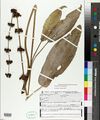Aquarius lanceolatus (Rataj) Christenh. & Byng[1]

Basionym :' Echinodorus lanceolatus Rataj
Root: Adventitious on rhizome and clonal on inflorescence. Stem: rhizome spindle-shaped; stem glabrous/not winged/triangular. Leaf: exserted elliptic/lanceolate/tip acute/base acute/veins acrodromous/translucent form absent; petiole triangular; submerged absent. Inflorescence: cymes erect/triangular/not winged/with vegetative propagation. Flower: monoclinal long pedicel/stalk cylindrical; sepal concave ovate/glabrous/persistent and recurved below achene; petal white/ovate; stamen number 18 to 24/stamens rounded/stamens acute; carpel freely numerous over 20. Fruit: obovate/3 to 4 ribbed/trichomes absent/1 to 5 gland(s)/gland(s) lenticular/beak erect. Seed: Shape obovate with ornamented surface.[2]
Description 60-100 cm tall, glabrous. Rhizome spindle-shaped, approx. 2.5 cm long. Leaves elliptic to lanceolate emerged, 10-27 cm long, 2.5-5 cm wide, apex acute, base thin to acute, acrodromous, 5-7 veins; secretory translucent ducts hidden; petiole triangular, 18-86 cm long; sheath 15-26 cm long. Inflorescence zymose; peduncle 52-121 cm long, erect, triangular, winged; rachis 27-29 long, triangular, not winged, 5-9 whorls, vegetative multiplication present; bracts ovate to lanceolate 10-25 mm long, glabrous, apex caudate. Flowers long-stalked; pedicel 3-3.5 mm long, semicircular; sepals ovate, recurved and not surrounding the acheneethum, 10-11 mm long; petals ovate, 10-12 mm long, without claws; stamens 19-24, secretory structures on dorsal side of anthers absent; carpels numerous, over 20. Achenes obovate, 2-2.4 mm long, 1-1.3 mm wide, 4 ribbed, trichomes absent on ribs, 1-4 glandular, gland lenticular, beak erect, ca. 0.2 mm long. Seeds approx. 1.3 mm long.[2]
Echinodorus lanceolatus is very similar to E. paniculatus. However, the fruits of E. lanceolatus have small glands, 1-5 units on the fruit surface, between the ribs, very often 4; and the mantle surface has longitudinal ribs and convex surfaces. Anatomische Unterschiede zwischen diesen Arten sind ersichtlich bei: Matias, L.Q., Soares, A., Scatena, V.L. 2008. Anatomie von Echinodorus (Alismataceae) Scapes aus dem Nordosten Brasiliens in Bezug auf die Taxonomie. Edinburgh J.Bot. 65(1):11-21; Matias, L. Q., Soares, A., Scatena, V. L. 2007. Systematische Betrachtung von Blattstielen von Arten von Echinodorus (Alismataceae) scapes aus dem Nordosten Brasiliens. Flora 202: 395-402[2]
Occurrence:
endemic Brazil Northeast, Southeast, West-Central
-
Echinodorus lanceolatus Rataj[3]
-
Echinodorus lanceolatus Rataj[4]
-
[5]Echinodorus lanceolatus Rataj
-
Echinodorus lanceolatus Rataj[6]
- ↑ POWO (2021). "Plants of the World Online. Facilitated by the Royal Botanic Gardens, Kew. Im Internet veröffentlicht; http://www.plantsoftheworldonline.org/Abgerufen am 22. August 2021."
- ↑ 2.0 2.1 2.2 Matias, L.Q. 2020. Alismataceae in Flora do Brasil 2020. Jardim Botânico do Rio de Janeiro.Available at: <http://reflora.jbrj.gov.br/reflora/floradobrasil/FB4262>. Accessed on: 14 Nov. 2021
- ↑ Louisiana State University, Shirley C. Tucker Herbarium (LSU-Vascular Plants)
- ↑ Collected in Brazil by Royal Botanic Gardens, Kew
- ↑ Echinodorus lanceolatus Rataj Collected in Brazil by Meise Botanic Garden
- ↑ Echinodorus lanceolatus Rataj Collected in Brazil by Meise Botanic Garden




